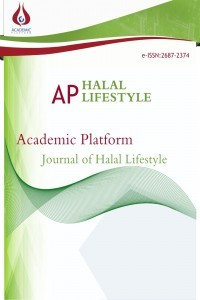İstihale Örneklerinin Gıda Katkı Maddelerine Yönelik Değerlendirilmesi
İstihale, kimyasal değişim, gıda katkı maddeleri
Evaluation of Food Additives in Terms of Istihalah
Istihalah, chemical changes, food additives,
___
- Al-Fatāwā Al-Hindiyyah. (1991). I, 42-45; V, 339. Beirut.
- Bilmen, Ö.N. (1986). Büyük İslam İlmihali. 57-60. Istanbul: Bilmen Printing and Publishing, in Turkish.
- Boran, M. (2019). Yiyecek ve İçeceklerimizde Helâl Haram Ölçüleri: Hanefi Mezhebinde Yiyecek ve İçeceklerde Helallik ve Haramlık Ölçüleri. Istanbul: Ravza Publications, in Turkish.
- Çayıroğlu, Y. (2013). İslâm Hukuku’na Göre Helâl Gıda Sorunu (Ph.D thesis). Marmara University Department of Basic Islamic Sciences, Islamic Law Department, 209-212, in Turkish.
- Dodwell, V., Bender, D., Botham, K., Kennelly, P., & Weil, P. (2019). Harper's Pictorial Biochemistry (Turkish 1st Ed.). Güneş Bookstore, 522.
- El-Hatîb, Y. b. N. (1424/2003). el-İstihālah ve ahkāmuhā fi’l-fiqhi’l-İslāmī. In Majalla Macmaʿi’l-fiqhi’l-İslāmī (XIV/16, 83–233). Mecca.
- El-Samragy, Y. (2016). The Use of Blood and Derived Products as Food Additives. In Food Additives. 239-266.
- Es-Semerkandi, A. (1998). Uyūnu’l-mesāil. 222, Beirut.
- Gündüz, H. (2009). Gıda Katkı Maddeleri ve Riskleri. VI. İslâm Hukuku Ana bilim Dalı Koordinasyon Toplantısı ve İslâm Fıkhı Açısından Helâl Gıda -Gıdalardaki Katkı Maddeleri- Sempozyumu: Bildiriler (ed. Ali Kaya et al.), 80–81. Bursa, in Turkish.
- Harvey, R., & Champe, P. (2007). Lippincott’s İllustrated Reviews Serisinden: Biochemistry. Nobel Medical Bookstores, 173.
- Harvey, R., & Champe, P. (2007). Lippincott’s İllustrated Reviews Serisinden: Biochemistry. Nobel Medical Bookstores, 296.
- Ibn Ābidīn. (1423/2003). Raddü Al-Muhtār. (Ed. Muavvaz, A.M & Abdülmevcûd, F.A). I, 519-520, 534. Riyadh.
- Ibn Rushd, Abu’l-Walīd Mohammad. (1988), Al-Bayān wa’t-Tahsīl. I, 155, Beirut.
- Jamaludin, M. - Ramli, M. A. (2012). Fiqh Istihalah: Integration of Science and Islamic Law. Revelation & Science. 02. 117-123.
- JECFA, (2000). Ammonium salts of phosphatidic acid”, Combined Compendium of Food Additive Specifications (online edition),
- http://www.fao.org/fileadmin/user_upload/jecfa_additives/docs/Monograph1/Additive-026.pdf (Access time; June 1, 2020).
- JECFA. (1973). Acetic and fatty acid esters of glycerol, Combined Compendium of Food Additive Specifications (online edition), http://www.fao.org/fileadmin/user_upload/jecfa_additives/docs/Monograph1/Additive-003.pdf (Access time; June 1, 2020).
- JECFA. (1993). Lecithin. Combined Compendium of Food Additive Specifications (online edition), http://www.fao.org/fileadmin/user_upload/jecfa_additives/docs/monograph4/additive-250-m4.pdf (Access time; June 1, 2020).
- Kara, H. H., Bor, Y. (2019). A review on: production, usage, health effect and analysis of mono- and diglycerides of fatty acids. Helal ve Etik Araştırmalar Dergisi, 1(1), 40-47.
- Laganà, P., Avventuroso, E., Romano, G., Gioffré, M.E., Patanè, P., Parisi, S., Moscato, U., Delia, S. (2017). Chemistry and Hygiene of Food Additives. Springer.
- Murray, RK., Granner, D.K., Mayes, P.A., Rodwell, V.W. (2019). Harper’s Illustrated Biochemistry. Lange Medical Books/McGraw-Hill Medical Publishing Division. 129-140.
- NIIR Board of Consultants & Engineers. (2005). The preparation of amino acids and proteins. In Handbook on Fine Chemicals, Vitamins, Amino Acids and Proteins. National Institute of Industrial Research, http://www.niir.org/books/book/zb,,e2_a_0_0_a/Handbook+on+Fine+Chemicals,+Vitamins,+Amino+Acids+and+Proteins/index.html (Access time; June 1, 2020).
- Okur, K.H. (2009). Permissible (halal) and forbidden (haram) foods in terms of islamic law and some current issues - İslam hukuku açısından helal ve haram olan gıdalar ve bazı güncel meseleler. Usûl: İslam Araştırmaları. 11, 7-40, in Turkish.
- Okur, K.H. (2016). Istihâle. In TDV İslâm Ansiklopedisi. Retrieved from https://islamansiklopedisi.org.tr/istihale-fikih (Access time; June 7, 2019), in Turkish.
- Şenol, Y. (2013). Kur’an ve Sünnet Işığında Helal Gıda. Suleymaniyah Foundation Publications. 115, in Turkish.
- Şimşek, M. (2019). Istihālah and Istihlāk in Terms of Halal Food in The Context of Contemporary Fiqh Problems - Helal Gıda Araştırmalarında Günümüz Fıkıh Problemi Olarak İstihâle ve İstihlâk. Halal and Ethical Research Journal, 1, 1–7, in Turkish.
- Yayın Aralığı: Yılda 2 Sayı
- Başlangıç: 2019
- Yayıncı: Akademik Perspektif Derneği
İstihale Örneklerinin Gıda Katkı Maddelerine Yönelik Değerlendirilmesi
Fatih GÜLTEKİN, Orhan ÇEKER, Adem ELGÜN, Mehmet GÜRBİLEK, Murat ŞİMŞEK, Rıfat ORAL, Saffet KÖSE, Selman TÜRKER, Hamdi DÖNDÜREN, Mustafa ÜNALDI, Erdoğan KÜÇÜKÖNER, Hasan YETİM, Ahmet AYDIN, Bülent DEDE, İsmail ÖZMEN, Levent BAŞAYİĞİT, Mustafa CENGİZ, Tahir TİLKİ, Sümeyye AKIN
Sağlıklı ve Kaliteli Yoğurt Nasıl Mayalanır?
Tek Sağlık Kavramı Açısından SARS-CoV-2 ve Diğer Coronaviruslar
OIC/SMIIC Standartları Çerçevesinde Helal Gıda Üretimi ve Helal Belgelendirme Süreçleri
Muhammet GÜNDÜZ, Fatih GÜLTEKİN, İbrahim KÜRTÜL
Ayetler ve Hadisler Doğrultusunda İslamî Mutfak Anlayışı
